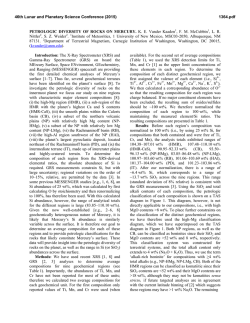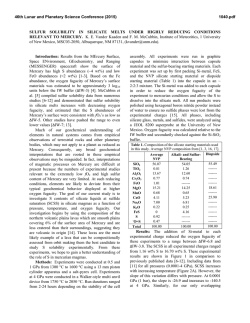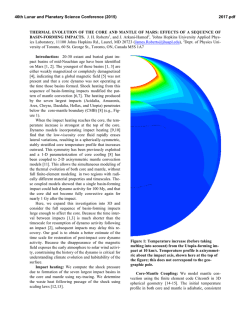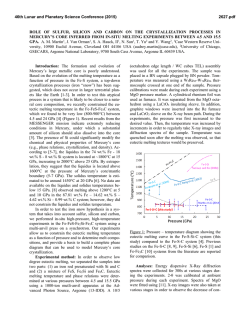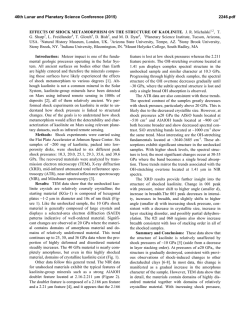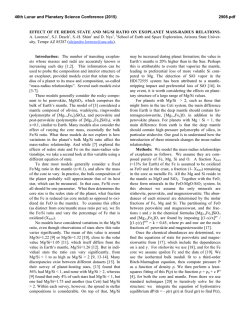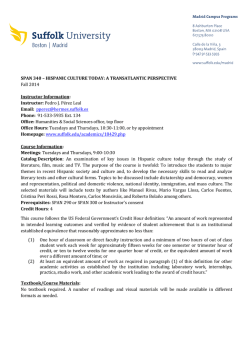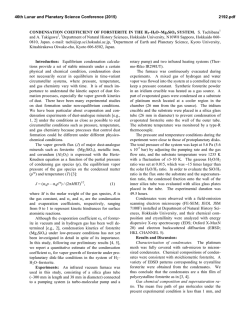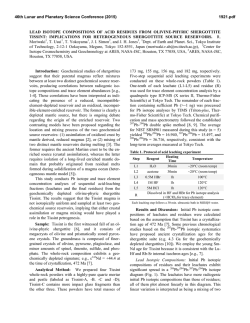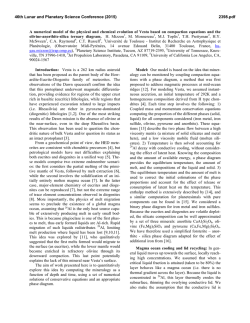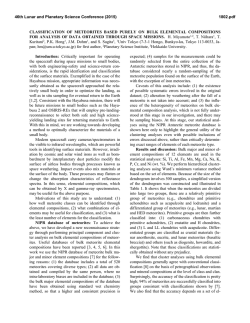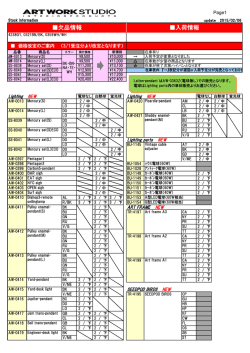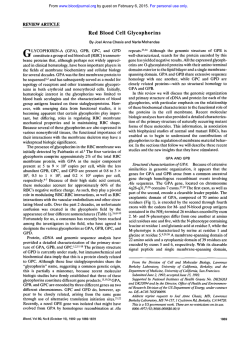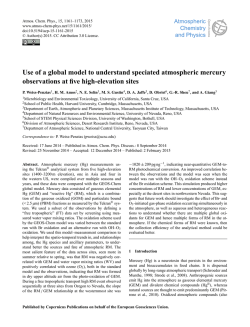
THE MANTLE SOURCES OF SURFACE LAVAS ON MERCURY. O
46th Lunar and Planetary Science Conference (2015) 1309.pdf THE MANTLE SOURCES OF SURFACE LAVAS ON MERCURY. O. Namur1, M. Collinet2, B. Charlier1,3, F. Holtz1, T.L. Grove2, C. McCammon4. 1Institute of Mineralogy, University of Hannover, Hannover, 30159, Germany ([email protected]), 2Department of Eath, Atmospheric and Planetary Sciences, Massachusetts Institute of Technology, Cambridge, MA 02139, USA, 3Department of Geology, University of Liege, Sart Tilman, 4000, Belgium, 4Bayerisches Geoinstitut, University of Bayreuth, Bayreuth, 95440, Germany. Introduction: Geochemical measurements of Mercury’s surface by the MESSENGER spacecraft during solar flare episodes have first been used to distinguish two main geochemical provinces: (1) the Northern Volcanic Plains and (2) the Intercrater Plains and Heavily Cratered Terrains (IcP-HCT)1. A more recent analysis combining solar flare and quiet sun data show that the geochemical provincialism is even more complex and that at least 7 geochemical terranes can be recognized2 (Fig. 1). 0.35 High Mg Region High Mg−Ca Region Caloris Basin High Mg NVP Low Mg NVP Rachmaninoff High Al Region IcP−HCT Exp NVP Exp Al/Si 0.30 0.25 0.20 0.15 0.20 0.30 0.40 0.50 0.60 0.70 Mg/Si Figure 1: Al/Si vs Mg/Si diagram showing average compositions and the 1σ chemical variability of Mercury’s geochemical provinces2. Starting compositions used for experiments are also shown. Low-pressure experimental investigation of Mercury’s low-Mg and high-Mg compositions indicate that the various geochemical provinces cannot be related by a common process of fractional crystallization. Geochemical provincialism is therefore better explained by the melting of several mantle reservoirs such as a lherzolitic source and a harzburgitic source3. These contrasted mantle sources may have been produced during magma ocean differentiation, but their vertical and lateral spatial distribution is currently unknown. In this study, we present intermediate- to high-pressure and high-temperature phase relationships of two compositions relevant to Mercury’s surface (IcP-HCT and NVP). Assuming that the mantle source region is polymineralic, we use experimental results to infer the multiple saturation point of surface lavas, i.e. the pressure and temperature of melt generation in the mantle based on the co-saturation of forsterite and enstatite as liquidus phases4. Given the relatively high sulfur content of Mercury’s lavas1, and the potential role of volatile species on phase equilibria5, we performed experiments on sulfur-free and sulfur-bearing starting compositions. Choice of starting compositions and experimental procedure: Starting compositions were selected based on XRS data from solar flares1. For NVP, we used median values of Mg/Si, Ca/Si and Al/Si ratios from 45 footprints to calculate absolute abundances of SiO2, MgO, CaO and Al2O3 in the starting composition. We also considered that NVP lavas contain 0.5 wt.% TiO21, 7 wt.% Na2O6 and 0.2 wt.% K2O7. Our NVP starting composition is relatively similar to the average composition of the low-Mg northern volcanic plain region2 (Fig. 1). For IcP-HCT, we used XRS data from 49 footprints with a Mg/Si ratio higher than 0.6. We also considered that IcP-HCT lavas contain 0.5 wt.% TiO21, 2 wt.% Na2O6 and 0.1 wt.% K2O7. Our IcP-HCT starting composition is very similar to the average composition of the high-Mg region2. The starting compositions were prepared by mixing high-purity oxides and silicates. Si metal was added to reach low oxygen fugacity conditions. For sulfurbearing experiments, sulfur was added as FeS. Sufficient sulfur was added (at least 15 wt.%) to the starting composition to ensure sulfide saturation in each experiment. Intermediate pressure experiments (0.1-0.7 GPa) were performed in large-volume internally heated pressure vessels with argon as the pressure medium. High-pressure experiments (0.8-2.5 GPa) were performed in end-loaded piston cylinders. The starting compositions (ca. 50 mg) were placed in a graphite capsule with a Pt outer jacket welded shut. Experiments were run for 4-8 hours at 1310-1650°C. As detailed below, FeS-bearing experiments contain metal immiscible globules (FeSi) in which the Si-content was used to constrain oxygen fugacity conditions to ca. IW4. Experiments in sulfur-free systems are expected to be more reduced. Results and discussions: Phase relationships – All experiments show a large proportion of quenched glass with a variable, but generally low, proportion of crystal phases. Sulfur-bearing experiments also show immiscible metal (FeSi) and sulfide (FeS) melts. For the sulfur-free NVP composi- 46th Lunar and Planetary Science Conference (2015) tion, experiments are saturated with forsterite from 0.1 to 1.0 GPa (1310-1410°C), forsterite and enstatite at 1.2 GPa (1440°C), and enstatite at 1.5-2.0 GPa (14501470°C; Fig. 2). These experimental data suggest that the position of the multiple saturation point (MSP) forsterite-enstatite-melt is situated at ca. 1.2 GPa and 1450°C. In the sulfur-bearing system, the appearance of enstatite is shifted to lower pressure with the MSP being located at ca. 0.75 GPa and ca. 1370°C. The difference between the pressure of the MSPs for sulfurfree and sulfur-bearing compositions can be attributed to the depression of liquidus in the presence of volatiles5. 1520 1500 IcP-HCT + Sulfur IcP-HCT No Sulfur Temperature (°C) 1480 1460 NVP+ Sulfur NVP No Sulfur 1440 1420 1400 1380 1360 1340 0.0 0.2 0.4 0.6 0.8 1.0 1.2 1.4 1.6 1.8 2.0 Pressure (GPa) Figure 2: Positions in a pressure-temperature diagram of the multiple saturation points (liquid+forsterite+enstatite) for the IcPHCT and NVP compositions. For the Mg-rich, sulfur-free, composition of IcPHCT, the MSP is located at significantly higher pressure and higher temperature (1.8 GPa; 1560°C) than the MSP of the NVP. In contrast, the MSP of the sulfur-bearing composition of IcP-HCT is located at relatively low pressure (0.75 GPa; 1450°C). The role of sodium on the MSP of NVP lavas – The northern volcanic plains on Mercury are strongly enriched in Na2O (6-7 wt.%) and to a lesser extent in K2O (ca. 0.20 wt.%). Part of this enrichment may be related to thermal migration of volatile elements6. However, the inverse correlation between Mg and K content of NVP lavas suggests that at least part of the enrichment is a primary feature of the mantle-derived melts2. The Na2O content of NVP lavas is rather variable, with the highest values observed in the northen parts. We used the pMELTS thermodynamic algorithm to put constraints on the influence of Na2O on the P-T location of the MSP. We observed that changing the Na2O content from 4 to 10 wt.%, while keeping other element ratios constant change the position of the MSP from 0.95 GPa to 1.4 GPa. In any case, the pressure of 1309.pdf MSP for the NVP composition is lower than that of the IcP-HCT composition. The role of fractional crystallization – Lavas erupted at the surface of the planet may not represent primary melts, e.g. in chemical equilibrium with the mantle residue. This is because melt differentiation may have occurred during melt ascent from the mantle source to the planet’s surface. We also used pMELTS to investigate the influence of olivine fractionation on the position of the MSP. We added incrementally up to 25 wt.% of a pure forsterite component to the NVP and IcP-HCT compositions and calculated the position of the MSP at each stage of back-fractionation. Results indicate that adding 25 wt.% of forsterite component increases the pressure of the MSP by 0.5 GPa and the temperature of the MSP by ca. 70°C. Implications for stratification of Mercury’s mantle – Projection of average compositions of Mercury’s geochemical province on pseudo-ternary liquidus sections confirms that at least two contrasted mantle source are needed to explain surface lava compositions3, a source with a clinopyroxene component (e.g. lherzolite) for high-Mg regions and a source free of clinopyroxene component (e.g. harzburgite) for the smooth plain regions. The MSPs that we obtained experimentally suggest that Mercury’s mantle may be vertically and possibly laterally stratified with a lherzolitic mantle at great depth (e.g. > 1.5 GPa) and a harzburgitic shallower mantle. Clinopyroxene High Mg Region High Mg−Ca Region Caloris Basi High Mg NV Low Mg NV Rachmaninof High Al Region Di Pi Oe Ol Olivine Opx Pr Qtz Quartz Figure 3: Projection of average composition of Mercury’s geochemical provinces from the anorthite onto the plane olivine, clinopyroxene, quartz. References: [1] Weider, S. Z. et al. (2012). J. Geophys. Res. 117, E00L05. [2] Weider, S. Z. et al. (2015). Earth Planet. Sci. Lett. [3] Charlier, B. et al. (2013) Earth Planet. Sci. Lett. 363, 50–60. [4] Asimow, P. D. & Longhi, J. (2004). J. Petrol. 45, 2349–2367. [5] Filiberto, J. et al. (2012) Chem. Geol. 312, 118–126. [6] Peplowski, P. N. et al. (2014) Icarus 228, 86–95. [7] Evans, L. G. et al. (2012) J. Geophys. Res. 117, E00L07.
© Copyright 2024
